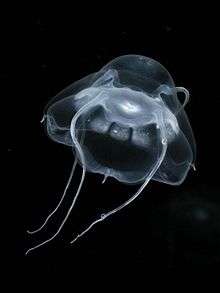Bathykorus
| Bathykorus bouilloni | |
|---|---|
 | |
| Scientific classification | |
| Kingdom: | Animalia |
| Phylum: | Cnidaria |
| Class: | Hydrozoa |
| Subclass: | Trachylinae |
| Order: | Narcomedusae |
| Family: | Aeginidae |
| Genus: | Bathykorus Raskoff, 2010 [1] |
| Species: | B. bouilloni |
| Binomial name | |
| Bathykorus bouilloni Raskoff, 2010 [2] | |
Bathykorus bouilloni is a species of jellyfish first described in 2010. It is a deep-sea species found in the Arctic Ocean, and seems to be common below about 1,000 m (3,300 ft).[3] It is the only species in its genus, Bathykorus.[2] The genus name comes from the Greek bathy meaning "deep" and korus meaning "helmet", referring to the depth at which this species is found and to the shape of the bell. Its helmet-like appearance bears a resemblance to the helmet of Darth Vader, giving it the nickname Darth vader jellyfish. The specific name is in honour of Dr. Jean Bouillon, (1926–2009), a marine zoologist.[4]
Description
B. bouilloni is a small, gelatinous jellyfish growing to around 2 cm (0.8 in) in width. It is transparent and pale blue, with four primary noncontractile tentacles set high above the margin of the dome-shaped bell. Lower down near the undulating margin are four short secondary tentacles, each with a statocyst on either side. The central circular mouth on the oral surface leads to a gastric chamber out of which lead 12 gastric pouches, three in each quadrant. The primary tentacles are solid and usually held above the bell in the direction of locomotion when the animal is foraging. The tentacles bear cnidocytes on the aboral side. The gonads have not yet been observed, perhaps because they were not ripe at the time of the year when observations were made (June/July).[4]
Distribution
B. bouilloni is found in the Arctic Ocean, especially around Greenland and the north of Canada. The jellyfish can only be found at an underwater depth range of 800 to 2,500 m (2,600 to 8,200 ft), but it is more common in the middle of this range.[3]
Biology
Because of the depths at which this species is found, it is not possible to visually observe it in situ, and observations are usually made by remotely operated underwater vehicles, nor is it easy to study specimens because they tend not to survive capture by netting. Some individuals have been caught by gentle suction and brought to the surface. It has proved possible to keep these alive in dark tanks at 1°C (34°F)for a week or more.[4]
References
- ↑ Peter Schuchert (2010). P. Schuchert, eds. "Bathykorus Raskoff, 2010". World Hydrozoa database. World Register of Marine Species. Retrieved February 5, 2012.
- 1 2 Peter Schuchert (2010). P. Schuchert, eds. "Bathykorus bouilloni Raskoff, 2010". World Hydrozoa database. World Register of Marine Species. Retrieved February 5, 2012.
- 1 2 Bathykorus bouilloni Raskoff , 2010 Arctic Ocean Diversity. Retrieved November 7, 2011.
- 1 2 3 Raskoff, Kevin A. (2010). "Bathykorus bouilloni: a new genus and species of deep-sea jellyfish from the Arctic Ocean (Hydrozoa, Narcomedusae, Aeginidae)" (PDF). Zootaxa. 2361: 57–67.